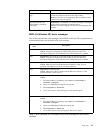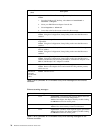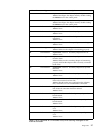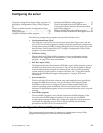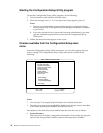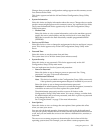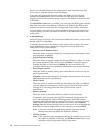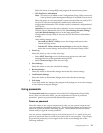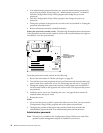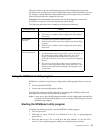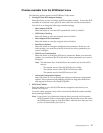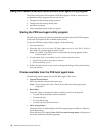Configuring the server 33
Select this choice to assign IRQs and program the master latency timer.
— PCI Slot/Device Information
Note: This choice is available on the Configuration/Setup Utility menu only
if the optional system management adapter is installed in your server.
Select this choice to view and identify system resources that are used by PCI
devices. PCI devices automatically communicate with the server
configuration information. This usually results in automatic configuration of
a PCI device.
Attention: You must use the menu selections to save custom settings for the
PCI Slot/Device Information choice. The Save Settings, Restore Settings,
and Load Default Settings choices on the main menu of the
Configuration/Setup Utility do not save the PCI Slot/Device Information
settings.
After making changes, select:
– Save and exit the PCI Utility to save the changes and return to the
Advanced Setup choice.
– Exit the PCI Utility without saving changes to discard the changes,
retain the current settings, and return to the Advanced Setup choice.
• Error Log
Select this choice to view or clear error logs.
— Select POST Error Log to view the three most recent error codes and
messages that the system generated during POST.
— Select Clear error logs to clear the error logs.
• Save Settings
Select this choice to save the customized settings.
• Restore Settings
Select this choice to discard the changes and retain the current settings.
• Load Default Settings
Select this choice to discard the changes and restore the factory settings.
• Exit Setup
If you have made any changes, the program will prompt you to save the changes
or exit without saving the changes.
Using passwords
The System Security choice appears only on the full Configuration/Setup Utility
menu. After you select this choice, you can implement two levels of password
protection: power-on password and administrator password.
Power-on password
Select this choice to set a power-on password. After you set a power-on password,
you can enable the unattended-start mode. This locks the keyboard and mouse, but
allows the system to start the operating system. The keyboard and mouse remain
locked until you type the correct password.
You can use any combination of up to seven characters (A–Z, a–z, and 0–9) for your
power-on password. Keep a record of your password in a secure place. If you forget
the power-on password, you can regain access to the server through one of the
following methods:



